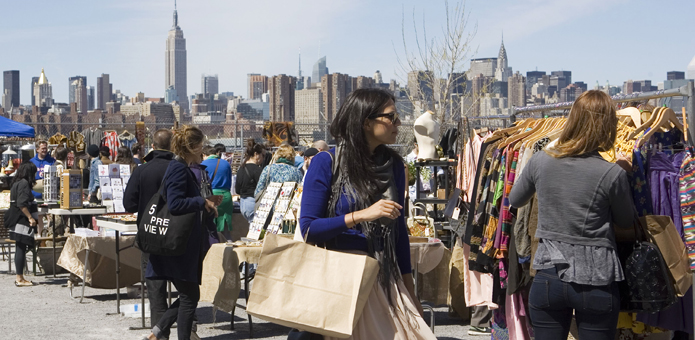Williamsburg (Brooklyn), the hippest place in America

By Harvey D. Shapiro
It’s the coolest place in New York. Indeed, it may well be the hippest place in all of America. And if you doubt that the Williamsburg section of Brooklyn deserves this title, ask any of its residents. Barely two decades ago, this neighborhood, located just across the East River from mid-Manhattan, was a rundown collection of warehouses, empty factories, and shabby apartment buildings. Now it’s home to thousands of black-clad young people, the ones you might see in Lena Dunham’s HBO hit series, “Girls,” which is filmed in the area. Many of Williamsburg’s residents are artists and software developers, musicians and writers – but a growing numbers of camp followers and wannabees, eager to live the bohemian life while holding a bourgeois job.

 But in recent years, every corner of Manhattan has been gentrified. In the Meatpacking district, for example, seemingly overnight all the butchers disappeared and the area has become filled with upscale restaurants and boutiques. Even the Bowery, a street whose name has come to mean a refuge for the poor and the homeless, has become filled with fancy restaurants, several chic hotels, and a new museum, called The New Museum. So starting a dozen years ago, those with more taste than income began to jump the river, pouring into Long Island City, Astoria, and above all Williamsburg.
But in recent years, every corner of Manhattan has been gentrified. In the Meatpacking district, for example, seemingly overnight all the butchers disappeared and the area has become filled with upscale restaurants and boutiques. Even the Bowery, a street whose name has come to mean a refuge for the poor and the homeless, has become filled with fancy restaurants, several chic hotels, and a new museum, called The New Museum. So starting a dozen years ago, those with more taste than income began to jump the river, pouring into Long Island City, Astoria, and above all Williamsburg.The northern part of Williamsburg was populated by first or second generation immigrants from Italy and Poland; the southern half was home to Hispanics and Hasidic Jews. The waterfront was a dying remnant of the industrial era in New York. Williamsburg was ugly– but it was just one stop from Manhattan on the subway.
Gentrification began with artists renting floors in buildings that were once factories and offered large open spaces for painting or practicing music. To serve the new arrivals, the area’s many bodegas began to be joined by places offering organic food, artisan breads, elegant coffee, and craft beers. Art galleries opened up, and more and more people poured into the area. Now the shops selling workingman’s overalls and nurses uniforms have been supplanted by stores specializing in $300 blue jeans and $500 peasant blouses.
Meanwhile, as the city government has given up on reviving industrial New York, it has rezoned Wiliambsburg’s industrial areas for residential use; so more and more factory buildings are being turned into apartments. The waterfront is becoming lined with new high rise apartment buildings offering views of the Manhattan skyline on one side and ready access to Williamsburg street life on the other. Reflecting the growing population of Williamsburg, last year the Metropolitan Transit Authority sought to ease subway overcrowding by adding 98 weekly roundtrips on the L train, which connects Williamsburg to Manhattan. And there is now a ferry boat from Williamsburg to Manhattan.
Although the newcomers profess great affinity for the working class and admiration for the authenticity of immigrants, they have essentially pushed both groups out of the neighborhood by bidding up prices. The old-timer can no longer afford the rents, and the building owners have been happy to sell their properties to some kid with a trust fund and move to Florida or go back to Sicily or Warsaw.
 In south Williamsburg, however, the Satmar Hasidim, an especially pious group of Hasidic Jews is standing firm. Their major institutions – their synagogues and schools — are there, and they need to get to them on foot on the Sabbath and holidays, when they are prohibited from riding, so they’re not moving. This has created a cultural clash. Among the thousands of Satmar, the traditional outfit is a black suit and a white shirt with no tie and a yarmulke (skullcap) for the men and a modest dress plus a wig or headscarf for the women. They are deeply offended by the traditional summer garb of Williamsburg’s newer residents — cutoff jeans, tank tops, and no bras – and they have posted signs asking for modesty.
In south Williamsburg, however, the Satmar Hasidim, an especially pious group of Hasidic Jews is standing firm. Their major institutions – their synagogues and schools — are there, and they need to get to them on foot on the Sabbath and holidays, when they are prohibited from riding, so they’re not moving. This has created a cultural clash. Among the thousands of Satmar, the traditional outfit is a black suit and a white shirt with no tie and a yarmulke (skullcap) for the men and a modest dress plus a wig or headscarf for the women. They are deeply offended by the traditional summer garb of Williamsburg’s newer residents — cutoff jeans, tank tops, and no bras – and they have posted signs asking for modesty.While the south has lagged the north in redevelopment, that is likely to change soon. This spring the city government approved plans to redevelop an 11 acre site that once housed a Domino Sugar refinery. The $1.5 billion project will include offices, retail space and nearly 2300 apartments. The centerpiece will be a 55 story apartment tower.
As elegant high rise apartment buildings offering doormen and rooftop sun decks have replaced warehouses, Wiliamsburg’s newcomers are increasingly likely to be bankers and advertising executives rather than artists, and they’re prepared to pay Manhattan-level prices for apartments. So, just as rising prices in Greenwich Village pushed the pioneers into Williamsburg, now the same forces are pushing Williamsburg pioneers in two directions: north, into Greenpoint, and eEast into Bushwick.
Greenpoint, traditionally a Polish neighborhood, has continued to see an influx of Poles since the Iron Curtain fell – not all the Polish plumbers went to London. But there’s an even bigger influx of hipsters. The kielbasa establishments once filled with Polish grandmothers in sensible shoes are now also serving newcomers carrying their iPads, ipods, and iphones. Many of the venues shown in Lena Dunham’s television show are actually in Greenpoint, not Williamsburg — but never in Manhattan. And the Greenpoint Lumber Exchange, setting for scenes in HBO’s “Boardwalk Empire,” is being redeveloped to include 4000 apartments.
 In addition to Greenpoint, there are also hipster forays into Bushwick, a heavily minority neighborhood just east of Williamsburg. But as many of Williamsburg’s original hipsters get married and start having children, their next step is often the Park Slope section of Brooklyn. That’s the neighborhood where the new mayor, Bill de Blasio, comes from, and it offers more child-friendly amenities, from playgrounds to better schools, while still emitting a strong artistic vibe — It sometimes seems like half the writers in America live in Park Slope.
In addition to Greenpoint, there are also hipster forays into Bushwick, a heavily minority neighborhood just east of Williamsburg. But as many of Williamsburg’s original hipsters get married and start having children, their next step is often the Park Slope section of Brooklyn. That’s the neighborhood where the new mayor, Bill de Blasio, comes from, and it offers more child-friendly amenities, from playgrounds to better schools, while still emitting a strong artistic vibe — It sometimes seems like half the writers in America live in Park Slope.For the purists, Williamsburg is over. Like Greenwich Village, Soho, and Chelsea, it is overrun by people with more money than creative talent, precisely the people the artists were trying to get away from. But for those who are always a couple steps behind the avant garde, Williamsburg gets better and better. There’s a constant stream of refurbished buildings coming on the market with architecturally interesting apartments – at Manhattan prices. There’s no need to go into Manhattan amid the sea of artisanal food shops, upscale restaurants, and live music venues. Indeed, there is a new “bridge and tunnel” crowd in New York — Manhattan residents drawn to the nightlife in Williamsburg.













Social